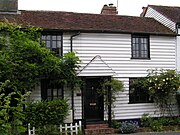
Weatherboarded Cottage, Petteridge. This style of building is very common in rural west Kent

Steve Woody House in Big Cataloochee, located in the Great Smoky Mountains of North Carolina. The house was originally a log cabin built in 1880-1881, with framed additions and weatherboarding completed in the early 1900s
Weatherboarding is the cladding or ‘siding’ of a house consisting of long thin timber boards that overlap one another, either vertically or horizontally on the outside of the wall. They are usually of rectangular section with parallel sides. Some horizontal sections have a tongued and grooved joint arranged to link the boards together, they can also be similar to North American riven clapboards of triangular or "feather-edged" section where the upper edge is the thinner one. Generally vertical boarding uses rectangular sections placed alternatively heart side in, heart side out (heart side means the side of the wood being nearest the heartwood, the central sap-less core of the original treetrunk).[1] This is done in order to encourage the boards to cup against one-another in a similar fashion to traditional terracotta roof tiles. This detail can also be used in an angled roof condition.
Traditionally timber weatherboarding was used without a finish, relying upon good air circulation and the use of 'semi-hardwoods' which would keep the boards from rotting. These boards eventually go grey as the tanins are washed out from the timber. More recently weatherboarding has been tarred or painted; traditionally black or white due to locally occurring minerals or pigments. In modern weatherboarding these colours remain popular, but with a hugely wider variety due to chemical pigments and stains. In some conditions weatherboards may consist of uPVC boards (Known as Vinyl siding in the U,S,), or other man-made materials. Recently there has been a much greater use of untreated timber cladding, using woods like Sweet Chestnut or Douglas-fir, with a well ventilated cavity. With robust detailing this weatherboarding can last for decades.
It is good practice to leave the lower part of a wall free of cladding to avoid dampness caused by air not circulating which could subsequently rot the weatherboarding. Watermills were traditionally made of brick up to the first floor, and in windmills upper storeys were often timber-framed and only the caps were weatherboarded.
Weatherboard houses may be found in most parts of the British Isles, and the style may be part of all types of traditional building, from cottages to windmills, shops to workshops, as well as many others.
In New Zealand, weatherboard housing dominates buildings before 1960. Weatherboard, with a corrugated iron roof was found to be a cost effective building style. After the big earthquakes of 1855 and 1931 wooden buildings were perceived as being less vulnerable to damage.
External links[]
References[]
- ↑ http://www.popularwoodworking.com/article/Finish_Both_Sides_Not_Necessary/ Heart side of boards
This page is being imported from Wikipedia, to create a Wikidwelling stub or article. These steps need to be completed:
The original article was at Weatherboarding. The list of authors can be seen in the history for that page. The text of Wikipedia is available under the CC-BY-SA 3.0 license. |
